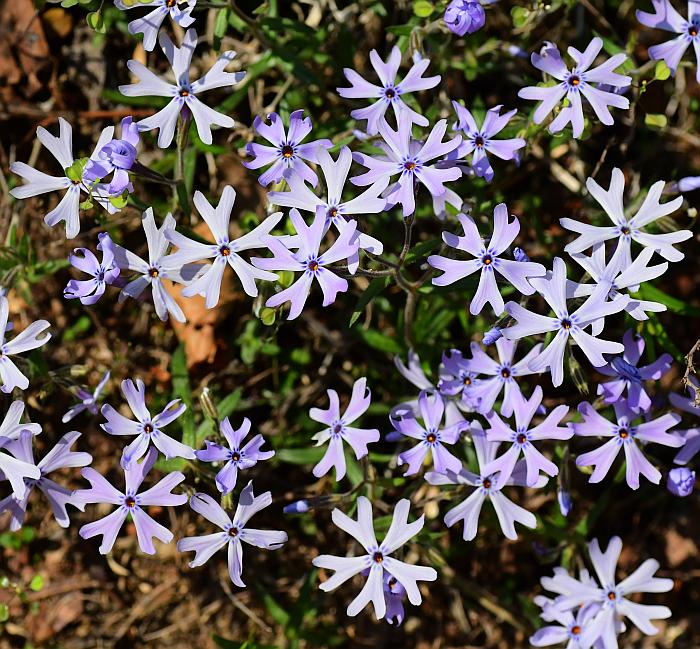Phlox bifida L.C. Beck
Cleft Phlox

Native
CC = 8
CW = 5
MOC = 17
SRank = S1
© SRTurner
Phlox bifida L.C. BeckCleft Phlox | |
 |
Native CC = 8 CW = 5 MOC = 17 SRank = S1 |
© SRTurner |
|
Family - Polemoniaceae Habit - Perennial forb with woody, often branched rootstocks, forming open mats or low, loose mounds, with short primary rhizomes. Stems - Vegetative stems spreading or weakly ascending, sometimes initially forming tufts of long leaves at congested nodes, these leaves otherwise morphologically similar to those of the flowering stems. Flowering stem branches ascending to erect, numerous, produced from the vegetative stems, to 30 cm tall, with 4-6 nodes, usually densely pubescent with curved or crinkled, multicellular hairs, these often all or mostly gland-tipped, at least toward the stem tip.
Leaves - Opposite, the blades typically variable on a given plant, those of the largest leaves 2.5-5.5 cm long and 1-4 mm wide, linear to narrowly lanceolate, entire, sessile, acute, with a single midrib, the surfaces and margins of the uppermost leaves moderately to densely pubescent with curved or crinkled, multicellular, often gland-tipped hairs, progressively less hairy toward the stem base, those of the lowermost leaves often glabrous or nearly so.
Inflorescence - Relatively few-flowered clusters, with 3-25 flowers or occasionally reduced to solitary flowers. Flower stalks 3-30 mm long, hairy. Flowers - Calyces 5.0-9.5 mm long, the lobes each tapered evenly to a short sharp extension of the midnerve, usually glandular-hairy, joined in lower 1/2 by scarious tissue. Corollas salverform, 5-lobed, pale bluish purple or light lavender to white, the tube 8-14 mm long, glabrous externally, the lobes 5.0-12.5 mm long and 3-8 mm wide, obovate, with a conspicuous apical notch 1.5-5.0 mm deep, often with darker spots of color at base. Stamens 5, with the filaments 5-11 mm long, the anthers positioned from below to at or above the stigma at the mouth of the tube. Ovary ovoid, superior, green, glabrous, 1.2 mm long, 3-locular. Placentation axile. Style greenish-white, 5-10 mm long, glabrous. Stigmas 3, 0.5-1.0 mm long.
Fruits - Capsules with 3 valves and 3 seeds. Flowering - March - May. Habitat - Glades, rocky and dry open woods, bluffs, rocky outcroppings, streambanks, roadsides. Also widely cultivated. Origin - Native to the U.S. Lookalikes - P. subulata. Other info. - This striking plant is found in a handful of widely-scattered Missouri counties, and in a few other Midwestern states. It is uncommon in most places, and in Missouri it carries a conservation ranking of S1 (critically imperiled). It is easily recognized by its low, creeping habit and distinctive flowers with cleft lavender petals. Since the plant is often cultivated as an ornamental, some records may represent escapes rather than natural populations.
Photographs taken off Main St., Liberty, MO., 4-14-00, and in the Piney Creek Wilderness, Barry County, MO., 4-4-04 (DETenaglia); also at Silver Mines Recreation Area, Madison County, MO, 3-19-2012, 4-3-2016, and 4-6-2021 (SRTurner). |